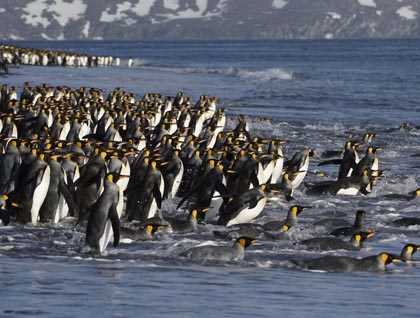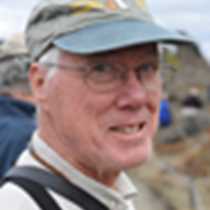The long-anticipated moment has arrived: our arrival at the Antarctic Island of South Georgia. Last night we completed our remarkably smooth and comfortable voyage from the Falkland Islands to drop anchor in the Bay of Isles, near the northwest corner of South Georgia. There, on the long, low beach of Salisbury Plain, and extending up onto the adjacent hills, we find an estimated 60,000 breeding pairs of king penguins, the second-largest colony on South Georgia. Why waste any of the day? At 5:00 AM we were boarding our Zodiacs for the trip ashore, a chance to view and photograph the penguins, elephant seals, and fur seals in the early morning light. The sight and sounds defy description: hundreds of king penguins cavorting in the surf near our beach landing; thousands more standing in groups molting their old feathers in preparation for breeding, and then the colony, itself - tens of thousands more packed cheek to jowl. (Do penguins have jowls? I think not.) King penguins have a most unusual breeding system. Eggs laid last December and January hatched into small, gray chicks that became larger juveniles clothed in brown down that looks ever-so-much like a bearskin coat (or, some would say, like young sailors coated in the mixture of frayed rope fibers and tar called oakum), and these have survived the winter with infrequent meals from their parents. Now, these "oakum boys" stand in the colony in groups, waiting for a parent to return to feed them. Soon they will complete their development and exchange their brown down for a handsome coat of gray, white, and black feathers with the bright orange splash that will identify them as king penguins.
For the afternoon outing, we moved a very short distance to Prion Island. Rats are the scourge of oceanic islands worldwide. They reached South Georgia from sealing vessels in the late 18th and 19th centuries. Where there are rats, ground nesting and burrowing birds have no chance, and the rats have largely removed such birds from the main island of South Georgia. Fortunately, rats have never colonized some of the smaller offshore islands and here a rich avifauna remains. Prion Island is one of the places where wandering albatross continue to nest. We landed on a small gravel beach and passed between Antarctic fur seal bulls, recently returned to the island to begin their breeding activities, to reach a boardwalk leading up to the albatross breeding areas. We passed numerous South Georgia pipits on the beach and in the tussock grass alongside the boardwalk. These are the world's southernmost and only Antarctic breeding songbird, and a sure indicator of rat-free conditions. Before the introduction of rats, they must have bred much more widely on South Georgia. Now, with the removal of rats (we will hear more on that as our trip progresses), we can hope for the return of albatrosses, pipits, and other bird species to breed on the main island and help to reverse the unfortunate trend of declining albatross numbers caused by mortality from long-line fisheries in the Southern Ocean.









